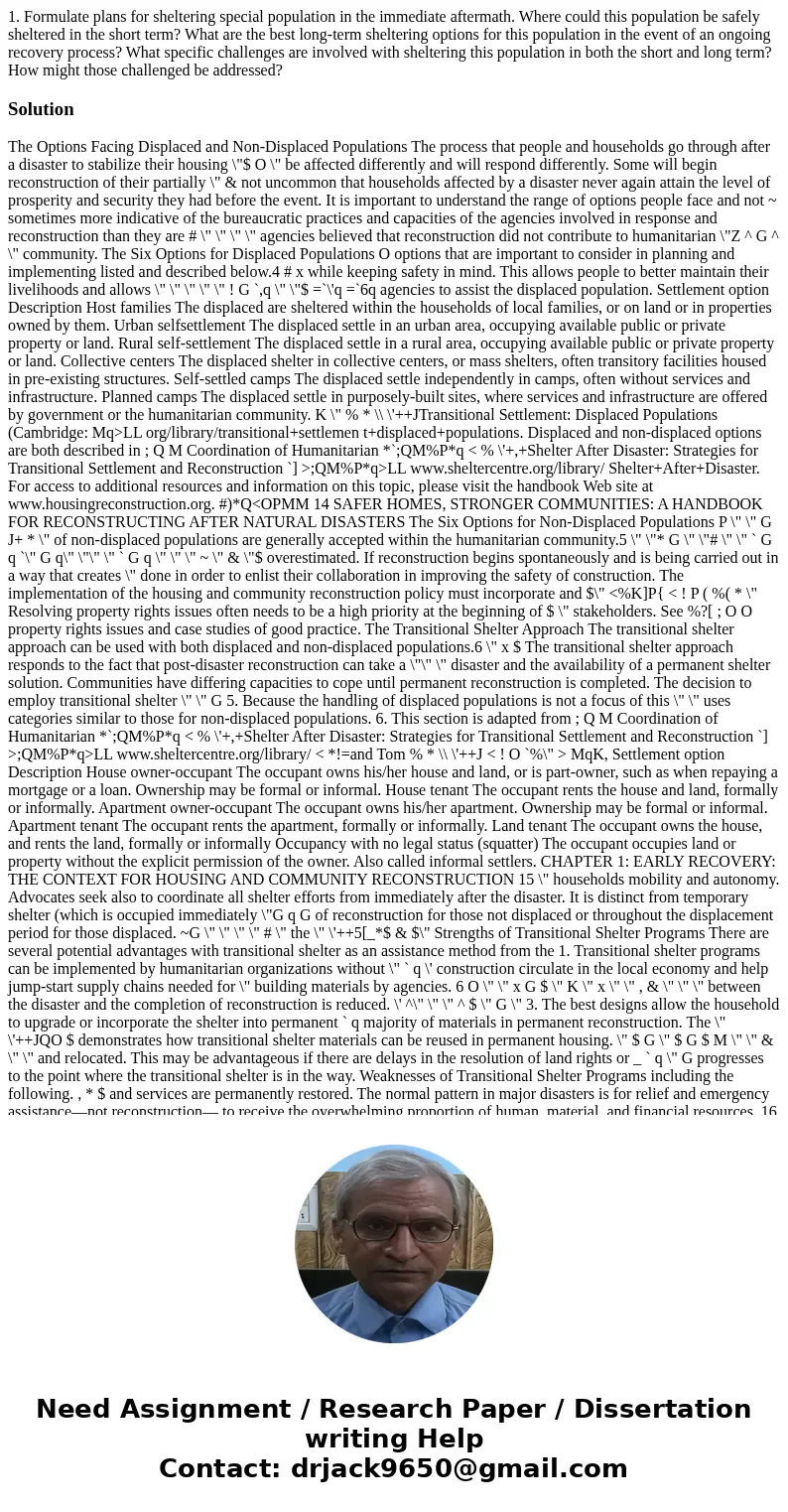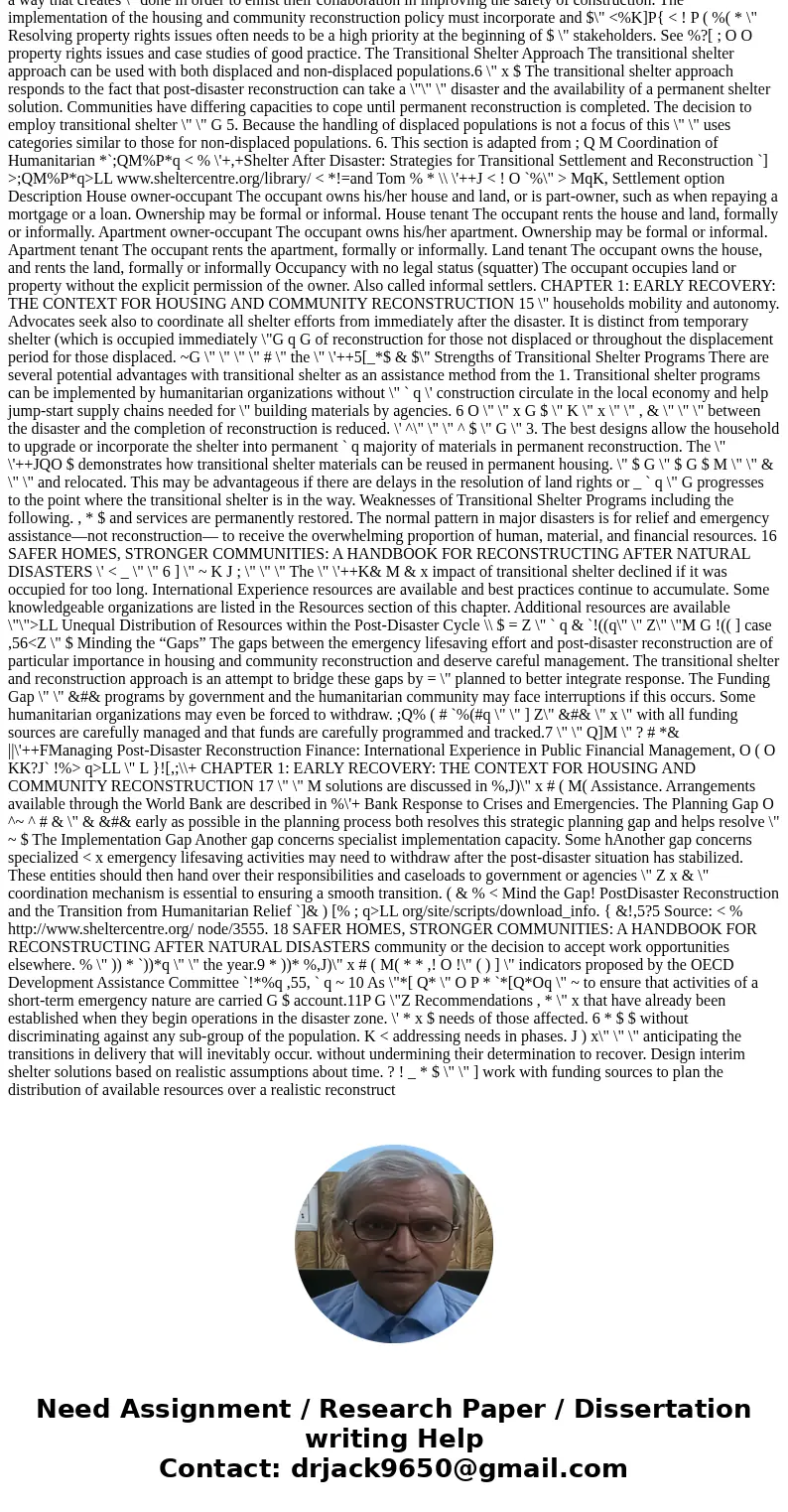1 Formulate plans for sheltering special population in the i
1. Formulate plans for sheltering special population in the immediate aftermath. Where could this population be safely sheltered in the short term? What are the best long-term sheltering options for this population in the event of an ongoing recovery process? What specific challenges are involved with sheltering this population in both the short and long term? How might those challenged be addressed?
Solution
The Options Facing Displaced and Non-Displaced Populations The process that people and households go through after a disaster to stabilize their housing \"$ O \" be affected differently and will respond differently. Some will begin reconstruction of their partially \" & not uncommon that households affected by a disaster never again attain the level of prosperity and security they had before the event. It is important to understand the range of options people face and not ~ sometimes more indicative of the bureaucratic practices and capacities of the agencies involved in response and reconstruction than they are # \" \" \" \" agencies believed that reconstruction did not contribute to humanitarian \"Z ^ G ^ \" community. The Six Options for Displaced Populations O options that are important to consider in planning and implementing listed and described below.4 # x while keeping safety in mind. This allows people to better maintain their livelihoods and allows \" \" \" \" \" ! G `,q \" \"$ =`\'q =`6q agencies to assist the displaced population. Settlement option Description Host families The displaced are sheltered within the households of local families, or on land or in properties owned by them. Urban selfsettlement The displaced settle in an urban area, occupying available public or private property or land. Rural self-settlement The displaced settle in a rural area, occupying available public or private property or land. Collective centers The displaced shelter in collective centers, or mass shelters, often transitory facilities housed in pre-existing structures. Self-settled camps The displaced settle independently in camps, often without services and infrastructure. Planned camps The displaced settle in purposely-built sites, where services and infrastructure are offered by government or the humanitarian community. K \" % * \\ \'++JTransitional Settlement: Displaced Populations (Cambridge: Mq>LL org/library/transitional+settlemen t+displaced+populations. Displaced and non-displaced options are both described in ; Q M Coordination of Humanitarian *`;QM%P*q < % \'+,+Shelter After Disaster: Strategies for Transitional Settlement and Reconstruction `] >;QM%P*q>LL www.sheltercentre.org/library/ Shelter+After+Disaster. For access to additional resources and information on this topic, please visit the handbook Web site at www.housingreconstruction.org. #)*Q<OPMM 14 SAFER HOMES, STRONGER COMMUNITIES: A HANDBOOK FOR RECONSTRUCTING AFTER NATURAL DISASTERS The Six Options for Non-Displaced Populations P \" \" G J+ * \" of non-displaced populations are generally accepted within the humanitarian community.5 \" \"* G \" \"# \" \" ` G q `\" G q\" \"\" \" ` G q \" \" \" ~ \" & \"$ overestimated. If reconstruction begins spontaneously and is being carried out in a way that creates \" done in order to enlist their collaboration in improving the safety of construction. The implementation of the housing and community reconstruction policy must incorporate and $\" <%K]P{ < ! P ( %( * \" Resolving property rights issues often needs to be a high priority at the beginning of $ \" stakeholders. See %?[ ; O O property rights issues and case studies of good practice. The Transitional Shelter Approach The transitional shelter approach can be used with both displaced and non-displaced populations.6 \" x $ The transitional shelter approach responds to the fact that post-disaster reconstruction can take a \"\" \" disaster and the availability of a permanent shelter solution. Communities have differing capacities to cope until permanent reconstruction is completed. The decision to employ transitional shelter \" \" G 5. Because the handling of displaced populations is not a focus of this \" \" uses categories similar to those for non-displaced populations. 6. This section is adapted from ; Q M Coordination of Humanitarian *`;QM%P*q < % \'+,+Shelter After Disaster: Strategies for Transitional Settlement and Reconstruction `] >;QM%P*q>LL www.sheltercentre.org/library/ < *!=and Tom % * \\ \'++J < ! O `%\" > MqK, Settlement option Description House owner-occupant The occupant owns his/her house and land, or is part-owner, such as when repaying a mortgage or a loan. Ownership may be formal or informal. House tenant The occupant rents the house and land, formally or informally. Apartment owner-occupant The occupant owns his/her apartment. Ownership may be formal or informal. Apartment tenant The occupant rents the apartment, formally or informally. Land tenant The occupant owns the house, and rents the land, formally or informally Occupancy with no legal status (squatter) The occupant occupies land or property without the explicit permission of the owner. Also called informal settlers. CHAPTER 1: EARLY RECOVERY: THE CONTEXT FOR HOUSING AND COMMUNITY RECONSTRUCTION 15 \" households mobility and autonomy. Advocates seek also to coordinate all shelter efforts from immediately after the disaster. It is distinct from temporary shelter (which is occupied immediately \"G q G of reconstruction for those not displaced or throughout the displacement period for those displaced. ~G \" \" \" \" # \" the \" \'++5[_*$ & $\" Strengths of Transitional Shelter Programs There are several potential advantages with transitional shelter as an assistance method from the 1. Transitional shelter programs can be implemented by humanitarian organizations without \" ` q \' construction circulate in the local economy and help jump-start supply chains needed for \" building materials by agencies. 6 O \" \" x G $ \" K \" x \" \" , & \" \" \" between the disaster and the completion of reconstruction is reduced. \' ^\" \" \" ^ $ \" G \" 3. The best designs allow the household to upgrade or incorporate the shelter into permanent ` q majority of materials in permanent reconstruction. The \" \'++JQO $ demonstrates how transitional shelter materials can be reused in permanent housing. \" $ G \" $ G $ M \" \" & \" \" and relocated. This may be advantageous if there are delays in the resolution of land rights or _ ` q \" G progresses to the point where the transitional shelter is in the way. Weaknesses of Transitional Shelter Programs including the following. , * $ and services are permanently restored. The normal pattern in major disasters is for relief and emergency assistance—not reconstruction— to receive the overwhelming proportion of human, material, and financial resources. 16 SAFER HOMES, STRONGER COMMUNITIES: A HANDBOOK FOR RECONSTRUCTING AFTER NATURAL DISASTERS \' < _ \" \" 6 ] \" ~ K J ; \" \" \" The \" \'++K& M & x impact of transitional shelter declined if it was occupied for too long. International Experience resources are available and best practices continue to accumulate. Some knowledgeable organizations are listed in the Resources section of this chapter. Additional resources are available \"\">LL Unequal Distribution of Resources within the Post-Disaster Cycle \\ $ = Z \" ` q & `!((q\" \" Z\" \"M G !(( ] case ,56<Z \" $ Minding the “Gaps” The gaps between the emergency lifesaving effort and post-disaster reconstruction are of particular importance in housing and community reconstruction and deserve careful management. The transitional shelter and reconstruction approach is an attempt to bridge these gaps by = \" planned to better integrate response. The Funding Gap \" \" &#& programs by government and the humanitarian community may face interruptions if this occurs. Some humanitarian organizations may even be forced to withdraw. ;Q% ( # `%(#q \" \" ] Z\" &#& \" x \" with all funding sources are carefully managed and that funds are carefully programmed and tracked.7 \" \" Q]M \" ? # *& ||\'++FManaging Post-Disaster Reconstruction Finance: International Experience in Public Financial Management, O ( O KK?J` !%> q>LL \" L }![,;\\+ CHAPTER 1: EARLY RECOVERY: THE CONTEXT FOR HOUSING AND COMMUNITY RECONSTRUCTION 17 \" \" M solutions are discussed in %,J)\" x # ( M( Assistance. Arrangements available through the World Bank are described in %\'+ Bank Response to Crises and Emergencies. The Planning Gap O ^~ ^ # & \" & &#& early as possible in the planning process both resolves this strategic planning gap and helps resolve \" ~ $ The Implementation Gap Another gap concerns specialist implementation capacity. Some hAnother gap concerns specialized < x emergency lifesaving activities may need to withdraw after the post-disaster situation has stabilized. These entities should then hand over their responsibilities and caseloads to government or agencies \" Z x & \" coordination mechanism is essential to ensuring a smooth transition. ( & % < Mind the Gap! PostDisaster Reconstruction and the Transition from Humanitarian Relief `]& ) [% ; q>LL org/site/scripts/download_info. { &!,5?5 Source: < % http://www.sheltercentre.org/ node/3555. 18 SAFER HOMES, STRONGER COMMUNITIES: A HANDBOOK FOR RECONSTRUCTING AFTER NATURAL DISASTERS community or the decision to accept work opportunities elsewhere. % \" )) * `))*q \" \" the year.9 * ))* %,J)\" x # ( M( * * ,! O !\" ( ) ] \" indicators proposed by the OECD Development Assistance Committee `!*%q ,55, ` q ~ 10 As \"*[ Q* \" O P * `*[Q*Oq \" ~ to ensure that activities of a short-term emergency nature are carried G $ account.11P G \"Z Recommendations , * \" x that have already been established when they begin operations in the disaster zone. \' * x $ needs of those affected. 6 * $ $ without discriminating against any sub-group of the population. K < addressing needs in phases. J ) x\" \" \" anticipating the transitions in delivery that will inevitably occur. without undermining their determination to recover. Design interim shelter solutions based on realistic assumptions about time. ? ! _ * $ \" \" ] work with funding sources to plan the distribution of available resources over a realistic reconstruct


 Homework Sourse
Homework Sourse